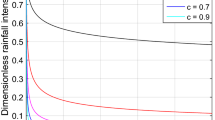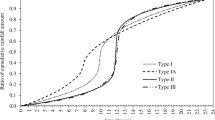Abstract
Due to the increase in global warming and climate change impact, especially in urban arid regions, the intensity-duration-frequency (IDF) curves and rainfall generation procedures become essential for storm design and hydraulic structures dimensioning for future planning and management. Al-Madinah, the second holiest city for all Muslims, is located in the western part of Saudi Arabia. This city needs special attention for hydrologic and hydraulic structure projects due to highly developed and rapid expansion in land use. The purpose of this study is to develop an empirical formula from IDF curves, which have been generated from 43-year records for Al-Madinah rainfall station. The absence of some daily rainfall records led to the application of the reduction method to disaggregate daily rainfall to hourly time series for developing suitable IDF curves. The formula is derived using the analysis of the best fit of Gumbel and log-Pearson Type III frequency methods. An average empirical formula can be used for predicting any return period with a given storm duration for Al-Madinah area. Generating wet, dry, and rainfall intensities are also investigated using autorun analysis on a daily time step. The results show that the dry spell continues for 71 days while the wet spell is about 1.58 days on the average based on the rainfall intensity threshold of 5.9 mm/day. Based on the goodness of fit for the dry and wet spells and the rainfall intensities, the daily rainfall sequences can be generated for any duration, which is adopted here as for the next 43 years.













Similar content being viewed by others
References
Alhassoun SA (2011) Developing an empirical formulae to estimate rainfall intensity in Riyadh region. J King Saud University –Engineering Sciences 23:81-88
Almazroui M (2011) Calibration of TRMM rainfall climatology over Saudi Arabia during 1998–2009. Atmos Res 99(3–4):400–414
Almazroui M, Islam MN, Athar H, Jones PD, Rahman MA (2012) Recent climate change in the Arabian peninsula: annual rainfall and temperature analysis of Saudi Arabia for 1978–2009. Int J Climatol 32:953–966
Alyamani M, Şen Z (1992) Regional variation of monthly rainfall amounts in the Kingdom of Saudi Arabia. J King Abdulaziz Univ FES 6:113–133
Artlert K, Chaleeraktrakoon C, Nguyen VT (2013) Modeling and analysis of rainfall processes in the context of climate change for Mekong, Chi, and Mun River Basins (Thailand). J Hydro Environ Res 7:2–17
Awadallah A, ElGamal M, ElMostafa A, ElBadry H (2011) Developing intensity-duration-frequency curves in scarce data region: an approach using regional analysis and satellite data. Eng Sci Res 3:215–226
Bell FC (1969) Generalized rainfall-duration-frequency relationships. J Hydraulic Div 95(HY1):311–347
Chow VT, Maidment D, Mays L (1988) Applied Hydrology. McGaw-Hill
Chowdhury R, Alam JB, Das P, Alam MA (2007) Short duration rainfall estimation of sylhet: IMD and USWB method. J Indian Water Works Assoc 285-292
EasyFit Professional (2009) Version 5.2, http://www.mathwave.com
Elfeki A, Al-Amri N (2010) Modeling monthly rainfall records in arid zones using Markov-Chains: Saudi Arabia case study, 4th Int’l Conf on Water Resources and Arid Land Environments (ICWRAE): 141–146
Elsebaie IH (2012) Developing rainfall intensity–duration–frequency relationship for two regions in Saudi Arabia. J King Saud Univ Eng Sci 24:131–140
Gong DY, Shi PJ, Wang JA (2004) Daily precipitation changes in the semi-arid region over northern China. J Arid Environ 59:771–784
Goyal MK (2014) Statistical analysis of long term trends of rainfall during 1901–2002 at Assam, India. Water Resour Manag 28:1501–1515
IPCC (2007) In: Solomon S, Qin D, Manning M, Chen Z, Marquis M, Averyt K, Tignor M, Miller H (eds) The physical science basis. Summary for policymakers. Contribution of working group I to the fourth assessment report. The Intergovernmental Panel on Climate Change. Cambridge University Press, Cambridge
IPCC (2012) In: Field CB, Barros V, Stocker TF, Qin D, Dokken DJ, Ebi KL, Mastrandrea MD, Mach KJ, Plattner G-K, Allen SK, Tignor M, Midgley PM (eds) Managing the risks of extreme events and disasters to advance climate change adaptation special report of the intergovernmental panel on climate change. Cambridge University Press, Cambridge 582
Koutsoyiannis D, Kozonis D, Manetas A (1998) A mathematical framework for studying rainfall intensity-duration-frequency relationships. J Hydrol 206:118–135
Lioubimtseva E (2004) Climate change in arid environments: revisiting the past to understand the future. Prog Phys Geogr 28:502–530
Maragatham RS (2011) Trend analysis of rainfall data—a comparative study of existing methods. Int J Phys Math Sci 2(1):13–18
Ministry of Water and Electricity (2014) Climate data reports. Hydrology Division, Riyadh
MRSC (2013) Madinah Research and Studies Center Publications. Al-Madinah Al-Muawarah, Saudi Arabia
Rathnam, E.V, Jayakumar, K.V, Cunnane C (2000) Runoff computation in a data scarce environment for urban storm water management—a case study, Ireland
Şen Z (1983) Hydrology of Saudi Arabia. Symposium on Water Resources in Saudi Arabia. Riyadh. A68-A94
Şen Z (1985) Autorun model for synthetic flow generation. J Hydrol 81:157–170
Şen Z (2009) Precipitation downscaling in climate modelling using a spatial dependence function. Int J Glob Warming 1:1–3
Subyani AM (2004) Geostatistical study of annual and seasonal mean rainfall patterns in southwest Saudi Arabia. Hydrol Sci J 49(5):803–817
Subyani AM (2012) Flood vulnerability assessment in arid areas, Western Saudi Arabia. Int J River Basin Manag 10(2):197–203
Subyani AM, Al-Ahmadi FS (2011) Rainfall-runoff modeling in the Al-Madinah area of Western Saudi Arabia. J Environ Hydrol 10(1):1–13
Subyani AM, Hajjar AF (2014) Rainfall analysis in the contest of climate change for Jeddah area, Western Saudi Arabia. Arab J Geosciences (under review)
Wentz F, Ricciardulli L, Hilburn K, Mears C (2007) How much more rain will global warming bring? Science 317(13):233–235
Zaman M, Rahman A, Haddad KH (2012) Regional flood frequency analysis in arid regions: a case study for Australia. J Hydrol 475:74–83
Author information
Authors and Affiliations
Corresponding author
Rights and permissions
About this article
Cite this article
Subyani, A.M., Al-Amri, N.S. IDF curves and daily rainfall generation for Al-Madinah city, western Saudi Arabia. Arab J Geosci 8, 11107–11119 (2015). https://doi.org/10.1007/s12517-015-1999-9
Received:
Accepted:
Published:
Issue Date:
DOI: https://doi.org/10.1007/s12517-015-1999-9




